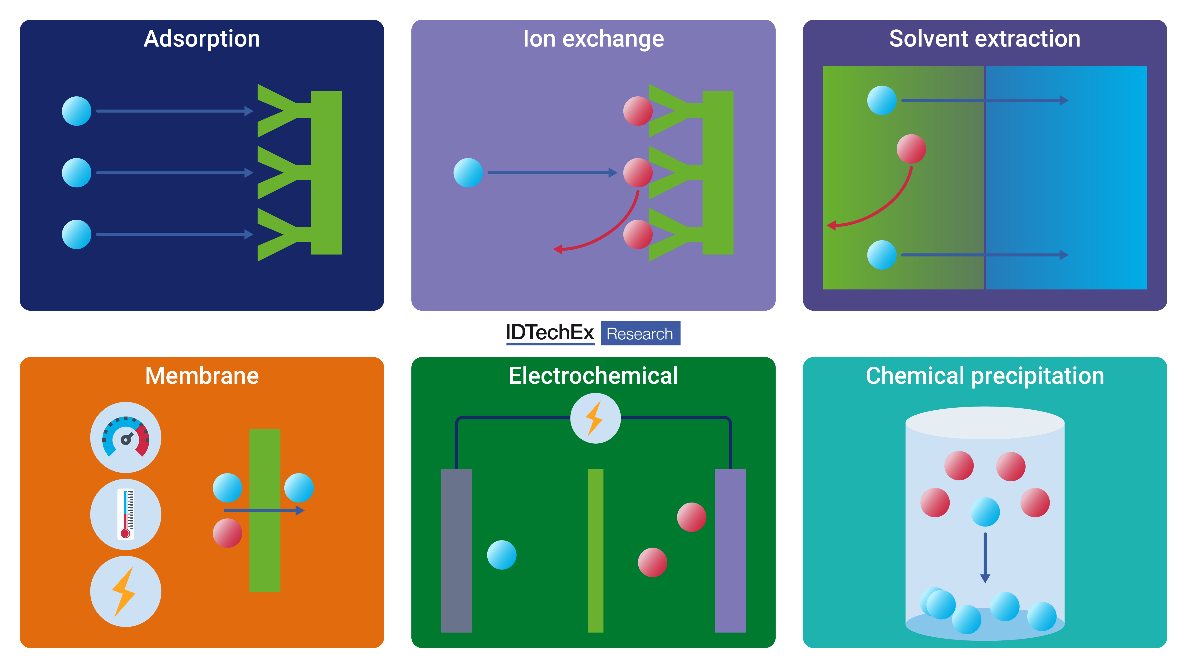Direct Lithium Extraction (DLE) is an emerging set of technologies aimed at addressing limitations in the conventional evaporative lithium mining method from brines. These techniques promise faster extraction times and higher yields, potentially broadening the range of usable brine resources across diverse geographical locations. As global lithium demand increases and regulatory landscapes shift, DLE's role in the evolving battery supply chain merits closer examination. IDTechEx’s report, “Direct Lithium Extraction 2025-2035: Technologies, Players, Markets and Forecasts”, predicts DLE to disrupt the brine mining market, with a compound annual growth rate (CAGR) of 19.6%, making it the fastest-growing segment in the industry. In contrast, the global lithium market is expected to expand at a CAGR of 9.7% between 2025 and 2035.
DLE to expand lithium extraction viability
Lithium brine resources exist in various forms, with continental brines being the most common and currently exploited source. These deposits include salt lakes/flats and are primarily found in the “lithium triangle” – covering regions in Bolivia, Chile, and Argentina. The Salar de Atacama in Chile, where leading lithium producers like SQM and Albemarle operate, is an example of this resource type. Recently, extracting lithium from geothermal and oilfield brines has received increased attention, thanks to the development of DLE. The viability of lithium extraction from these brine deposits depends on several factors. While lithium concentration (or grade) is a key determinant, variables such as impurity content, pH, and temperature cannot be ignored. The conventional lithium extraction method using evaporation ponds has stricter brine quality requirements. It targets brines with high lithium concentration and low impurity content – like those found in Salar de Atacama in Chile and Silver Peak in Nevada, USA. However, DLE technologies may be able to expand the range of viable brine resources, enabling lithium extraction from lower-grade brines and/or those with higher impurity content.
To unlock the potential of lithium brines, extensive research and testing is being conducted on DLE technologies. The diversity in lithium brine resources necessitates the development of customized processes, along with extensive testing, to determine the most promising and viable investment opportunities. Six distinct classes of DLE methods have emerged, and they are at different stages of development. Adsorption-based DLE has received the most attention, evidenced by the highest number of companies and projects dedicated to this approach. Adsorption DLE uses aluminum-based sorbents to capture lithium and water to release lithium salts, typically lithium chloride. This process is effective in brines with high salinity, where lithium ions are weakly hydrated/stabilized. As a result, these lithium ions, coupled with corresponding anions such as chloride, are selectively transported to the sorbent material. When lithium loaded sorbent is washed with water, an excess of free water molecules becomes available to lithium ions, allowing lithium ions to be strongly hydrated/stabilized in solution. This facilitates the release of lithium salts from the sorbent, resulting in the production of lithium salt solutions. This process requires a high volume of water. To reduce the overall water consumption, water recycling techniques are often employed at the cost of increased energy consumption. This situation creates a trade-off between water and energy consumption. Achieving sustainable water consumption metrics can, therefore, be a costly endeavor.

Six classes of lithium extraction and recovery technologies covered in the IDTechEx report, “Direct Lithium Extraction 2025-2035: Technologies, Players, Markets and Forecasts”. Source: IDTechEx
Ion exchange DLE is the second most advanced technology in the field. This technology typically uses manganese or titanium-based sorbents to capture lithium and releases lithium salts (e.g., lithium chloride or lithium sulfate) by washing with an acid, such as hydrochloric acid, for lithium chloride salt. A key advantage of ion exchange DLE is its ability to extract lithium from lower-grade brines and produce solutions with higher lithium concentrations than that of adsorption DLE. Consequently, the need for water separation and brine concentration can be lower compared to adsorption DLE. However, the use of acids presents challenges, such as the logistics of sourcing and transporting acids to extraction sites if they are not produced on-site. Additionally, the long-term performance of ion exchange materials requires monitoring due to a potentially faster rate of degradation and dissolution in acid. Unlike adsorption DLE, ion-exchange DLE is not yet commercially proven. Its performance and economic viability require further improvement for commercialization. DLE players, such as Standard Lithium and Controlled Thermal Resources, have favored adsorption DLE over ion exchange DLE to avoid the complexities associated with acid use.
The development of other classes of DLE technologies has generally lagged behind adsorption and ion exchange DLE. Solvent extraction DLE operates by selectively dissolving lithium from brines into solvents. This approach typically utilizes multi-component solvent systems comprising extractants, co-extractants, and bulk solvents. While solvent extraction has shown promise in producing high-purity lithium solutions, it remains underdeveloped, with only a few active players like Adionics and Ekosolve. The limited activity in this field can be partly attributed to factors such as the lack of effective lithium extractants and a limited understanding of process optimization for achieving high lithium selectivity and extraction efficiency.
Membrane technologies offer versatile solutions for recovering lithium from brines. These technologies can be categorized into pressure-driven, thermally-driven, and electrically-driven processes. While some membrane technologies, such as reverse osmosis and membrane distillation, are primarily employed for water separation within DLE workflows, others—like selective electrodialysis and nanofiltration—can achieve lithium extraction. Originally developed for water treatment and desalination, these technologies require adaptation for lithium separation in salty brines to address challenges like membrane scaling and fouling. The non-lithium-selective nature of many membranes often necessitates additional purification stages to achieve a high-purity lithium stream. Lithium-selective membranes, on the other hand, largely remain in the laboratory development phase. Challenges such as chemical stability and scalability must be overcome for practical use. Electrochemical and chemical precipitation DLE are predominantly in the laboratory research phase and require further development before they can be scaled up for commercial production.
Customized lithium extraction: adsorption-type DLE leading the way
DLE technologies can vary widely, with some being more energy-intensive while others may require higher amounts of reagents. Their effectiveness and cost profile can also differ, depending on the brine composition and the geographical location. The overall lithium recovery workflow and equipment are often tailored to the resource in question. However, companies are gravitating towards adsorption-based DLE methods. This preference is likely driven by several factors: adsorption is the most understood and currently the only commercially proven DLE technology. It also requires minimal/no chemical usage. Adsorption DLE is expected to dominate the market over the next 5-10 years.
IDTechEx’s report on direct lithium extraction provides an in-depth analysis of DLE technologies, including SWOT analyses of various methods and case studies of key industry players. For more information about the technological trends in DLE, commercial potential, and regulatory frameworks across countries with major lithium brine deposits, please see the report, “Direct Lithium Extraction 2025-2035: Technologies, Players, Markets and Forecasts”. Downloadable sample pages are available for this report.
For the full portfolio of batteries and energy storage market research available from IDTechEx, please visit www.IDTechEx.com/Research/ES.
Upcoming free-to-attend webinar
Unlocking Lithium Brine Potential: The Role of Direct Lithium Extraction
Dr Jiayi Cen, Technology Analyst at IDTechEx and author of this article, will be presenting a free-to-attend webinar on the topic on Wednesday 25 September 2024 – Unlocking Lithium Brine Potential: The Role of Direct Lithium Extraction.
The webinar will provide:
- Lithium mining and extraction: Fundamentals and current practices
- Direct lithium extraction (DLE): A comprehensive overview
- Sorbent-based DLE technology: In-depth exploration
- Evolving business models in the DLE market
- Sustainability and cost benchmarks across lithium extraction methods
- Lithium market outlook: Drivers, challenges, and emerging trends in DLE
We will be holding exactly the same webinar three times in one day. Please click here to register for the session most convenient for you.
If you are unable to make the date, please register anyway to receive the links to the on-demand recording (available for a limited time) and webinar slides as soon as they are available.


